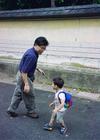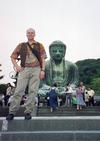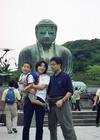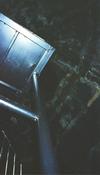 |
I guess James won the match. We proceeded to wash our money at the traditional
money-washing shrine zeniarai benten jinja (I kid you not). Jasper showed
us how - you dip water out with the dipper and pour it over. Of course,
after you wash your money (your coins, natch) you throw a couple of them
into the water as an offering.
|
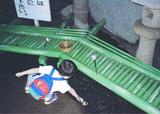 |
|
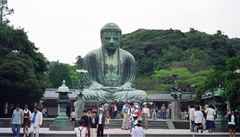
We then paid the small entrance fee for what everybody really comes to
Kamakura for -- the Daibutsu ("big buddha"). The Daibutsu is
totally amazing -- a truly huge bronze statue of Buddha erected in 1252.
In 1252, that had to be a lot of bronze (the statue is estimated to weigh
90 tons; it's 35 feet tall and about 85 meters across at the base). The
even more amazing fact is that the statue sat in a huge wooden temple
until 1494, when a huge tsunami swept over Kamakura (the Daibutsu is not
especially low or close to the shore, although Kamakura is a coastal town)
and washed the temple away around it. The statue remained unperturbed
-- now that's the kind of even that'll help get some legends started.
|
|
Now, for yet another small fee --
OK, at this point I was beginning to get an appreciation for why sometimes
there seems to be an association between Buddhist priests and greed in
Japanese books. Personally, I'm from America, so I prefer the word enterprising
to the word greedy, but I have to admit there were a lot of cost-exgtra
things for sale at all the temples I went to.
Anyway, for another ¥150 or so, you can play the stick fortune-telling
game. You hand over your change and the priest hands you a cylindrical
wooden box with a small hole in one end. You shake it until a stick comes
out of the hole. You then hand it back to the priest, who looks at the
number on your stick and hands you a sheet of paper with your fortune.
Fortunes come in three basic categories, "Big Luck," "A
Little Luck," and "It's OK" (as in, "it's OK, try
again next time").
The fortunes all have their prognostications for various areas (business,
travel, love, etc.) printed on the sheet of paper. Unless you were lucky
enough to get "Big Luck", you twist your fortune into a rope
and tie it around this bamboo rack, so as to leave behind the bad part
of the fortune and have only the good leave with you.
|
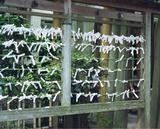 |
